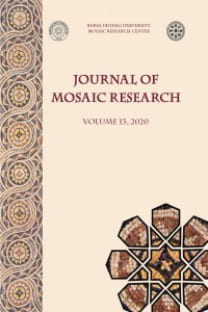Iconography of Marine Vessels Depicted in Mosaics and Its Importance to Marine Archaeology
This article deals with the iconography of ancient ships, depicted in mosaics of the Eastern Mediterraneancoast, from Syria, Lebanon, Jordan, Israel to Egypt. As shipping was one of the most important transports fortrade, and not only in the Mediterranean Region, artists frequently used ships as a subject of their artworks.Ships are depicted on frescoes (e.g. a drawing of a sailing boat in the Church of St. Vartan in the Church ofthe Holy Sepulchre in Jerusalem. Gibson 1994: 34-42), mosaics, coins, even engraved on walls, such as on thewall at the crusader castle in Akko Israel. It is important to mention that in ancient times artists tried to conveya precise image of the objects they represented, thing that helps us to understand the exact appearance of theresearched boats; a trend not common in contemporary mosaic art.The mosaics we are referring to here were predominantly made from tesserae cubes measuring 1 sq. centimeter,but often smaller cubes were used to depict faces (Figs. 11, 12). Mosaics depicting ships have been discoveredin various places such as churches (Fig. 12), public and private houses (Figs. 8, 11, 12), even under a threshing-floor (Fig. 5). In buildings, they were frequently included in stories (Fig. 8) often from Greek mythology(Thesaurus on a boat with Ariadne, Daszewski 1977: pl. 30) and in churches in medallions (Fig. 13).The earliest mosaic we describe in this article is the reed boat from El-Amarna, Egypt (Fig. 14), from the 1stcentury BC. Unlike wooden boats, remains from ancient reed boats have not been found, since they decay withtime. Nevertheless, their uses are known to us from literature and artworks. Furthermore, from the 2nd centuryAD and onwards, decorating churches (Fig. 13) and rich houses (Figs. 8, 11, 12) with mosaic floors started tobecome a common custom in this region.
___
- Avissar 1998 M. Avissar, “Lod – A Mosaic Floor”, ExcIsr 17, 169-172.
- Avi-Yonah 1972 M. Avi-Yonah, “The Haditha Mosaic Pavement”, IEJ 22, 118-122.
- Basch 1987 L. Basch, Le Musée Imaginaire de la Marine Antique, Athens.
- Casson 1971 L. Casson, Ships and Seamanship in the Ancient World, New Jersey.
- Daszewski 1977 A. W. Daszewski, Nea Paphos II, La mosaïque de Thésée, Vasovie.
- Daszewski 1985 A. W. Daszewski, Corpus of Mosaic from Egypt I: Hellenistic and Early Roman Period, Mainz.
- Gibson 1994 S. Gibson, “The Ship Drawing“, S. Gibson – J. E. Taylor (eds.), Beneath the Church of the Holy Sepulchre, Jerusalem: The Archaeology and Early History of Traditional Golgotha (Palestine Exploration Fund Monograph Series Major 1), London, 25-50.
- Grossmann 2011 E. Grossmann, Marine Craft in Ancient Mosaics of the Levant, BARIntSer 2249, Oxford.
- Linder - Kahanov 2003 E. Linder - Y. Kahanov, The Ma‘agan Michael Ship, Haifa.
- Meyboom 1995 P. G. P. Meyboom, Palestrina, Early Evidence of Egyptian Religion in Italy, Leiden, New-York, Cologne.
- Parker 1992 A. J. Parker, “Cargos, Containers and Stowage: the Ancient Mediterranean”, IntJNautA 21, 2, 89-100.
- Patrich - Tsafrir 1993a J. Patrich – Y. Tsafrir, “Beith Loya, Horvat”, E. Stern (ed.), The New Encyclopedia of Archaeological Excavations in the Holy Land, Jerusalem, 210-213.
- Patrich - Tsafrir 1993b J. Patrich – Y. Tsafrir, “A Byzantine Church Complex at Horvat Beith Loya”, Y. Tsafrir (ed.), Ancient Churches Revealed (Israel Exploration Society), Jerusalem, 265-272.
- Piccirillo 1993 M. Piccirillo, The Mosaic of Jordan, Amman.
- Raban 1988 A. Raban, “The Ship from Migdal Nunia”, Sefunim 7, 48-55.
- Stemm – Kingsley 2013 G. Stemm - S. Kingsley, Oceans Odyssey 3, The Deep-Sea Tortugas Shipwreck, Straits of Florida: A Merchant Vessel from Spain‘s 1622 Tierra Firme Fleet, Oxford and Oakville.
- Stronk 1992-93 J. P. Stronk, “Greek sailing merchant-ships, c. 500 - 330 B.C. A preliminary research”, Talanta 24-25: 117-140.
- ISSN: 1309-047X
- Başlangıç: 2008
- Yayıncı: Ululdağ Üniversitesi, Mozaik Araştırlmaları Merkezi
Sayıdaki Diğer Makaleler
Nadezhda A. DUBOVA, Natalia A. KOVALEVA, Galina E. VERESOTSKAYA, Anatolij M. YUMINOV
Nissma BOUZOUBAA, Abdelilah DEKAYİR
Amir GORZALCZANY, Baruch ROSEN
I. Uluslararası Apollonia Mozaik Çalıştayı 26 Ağustos - 1 Eylül 2019 - Gölyazı / Nilüfer / Bursa
Miguel PESSOA, Ana Luísa Ravara MENDES, Elsa Simões SIMÕES, Sónia VICENTE
